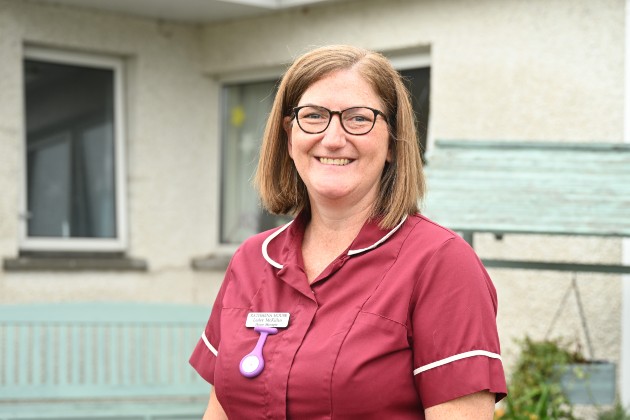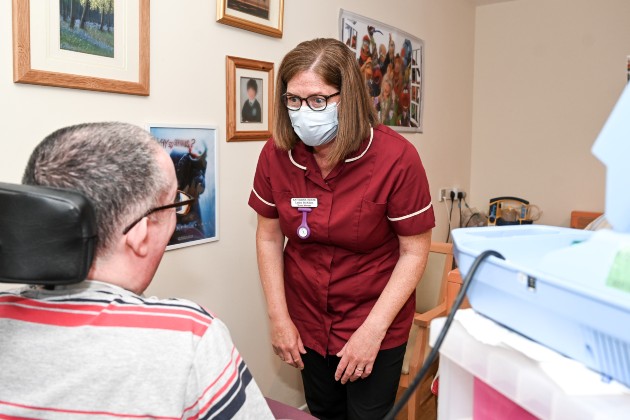When nurse and care home manager Lesley McKillen met this patient, a man of a similar age to her, something immediately struck her: “I thought, that could be me.”
The man had suffered a severe stroke that left him with significant physical disabilities. “He had a nine-year-old boy and obviously the stroke tore the family apart,” Lesley says.
Still only in his forties, the man’s nursing needs were complex and included tracheostomy care. A home care package had broken down and he had been hospitalised while alternative accommodation could be arranged.
He’d been let down by the system, so I couldn’t fail him
But suitable placements for younger people with acquired brain injury are hard to find, especially near to their home, and he had already spent two years in hospital.
Lesley manages Rathmena House in Ballyclare, County Antrim, which is registered to provide care for residents both over and under 65 years of age. When a district nursing sister and specialist social worker asked whether the home could take the man as a resident, Lesley – not one to duck a challenge – felt sure that she and her staff could help, despite the difficult logistics of managing his care needs.
Research and preparation
As she acknowledges, balancing the needs of a 40-year-old against those of a 90-year-old is not straightforward. “We had to be very careful, I couldn’t fail him,” says Lesley. “I thought, there must be more to life than just sitting in a hospital ward, this isn’t good enough. He’d been let down by the system, so it had to work, it had to be done right.”
Care homes excel at many things but nursing a resident with complex tracheostomy needs is rarely among them. This is a specialist area and Lesley had no expertise, so there was a lot of research and preparation to be done before she could be confident that she and her team could provide care of the highest standard.
“It was daunting for me,” she says. “I had to go and do a course in tracheostomy management.” Other staff had to be trained – and they also had to be sure they could meet all the other complex needs of their new resident. “It takes a certain person,” says Lesley of her colleagues. “It’s not just any carer who can do that.”

The team also had to prepare for all possible scenarios. What if a staff member was sick? Would someone else be able to provide the care required? “There were so many areas to cover,” Lesley says.
And then there was COVID-19. The man moved into Rathmena House just before the pandemic hit and Lesley admits she was “absolutely terrified” that he would succumb to the virus. “Obviously, with a tracheostomy tube you’re very, very vulnerable.”
But he didn’t. Nor did any of the other residents with tracheostomies who have subsequently been cared for at Rathmena House.
Keeping care local
Lesley was fortunate to have a supportive ally in a consultant at the Northern Health and Social Care Trust. “He comes out to change the tracheostomy tubes in the home so now we’re providing that service too. The staff assist and one has actually changed the tube, supervised by the consultant.”
The alternative would be to send each resident with a tracheostomy, in an ambulance and with an escort, to outpatients every month, increasing the risk of infection and eating up time and resources.
To put Lesley’s achievements into perspective, she and her team are providing specialist nursing care in a residential home in a small town some distance from expert support. As she says, it’s not as if Rathmena House is in the middle of Belfast, close to a major hospital that can intervene if things go wrong.
But with all the current emphasis on keeping care local, Rathmena House exemplifies that approach.
“This man’s son now walks up from school to visit him. He’s five minutes from his family home. And that’s what this is all about – not bringing everyone to one central location but keeping them where they live.”

Lesley’s incredible success was acknowledged in the RCN Northern Ireland Nurse of the Year awards, announced in June, where she won runner-up.
“That meant everything for me,” she says. “But I couldn’t do it without everyone in this home being behind me. I have a fantastic team and have never felt so proud in all my life.”
The award also brought a welcome focus on care homes: “It was recognition not only for myself but for the home. And not just my home but all care homes in Northern Ireland. Some people will say, ‘You work in a care home, that’s an easy job’. There is that sort of stigma, so it’s nice to get it out there that there are care homes that are doing good, that have good standards of care and can really offer something a bit different.”
The recognition has also given her the confidence to keep pushing boundaries: “We didn’t think we could do what we did, but we have and we’ve done it well. Now, there are endless possibilities.”
Find out more
For nursing staff interested in learning more about tracheostomy, Lesley recommends the National Tracheostomy Safety Project (NTSP) as a useful starting point. The NTSP was set up by four doctors keen to improve the management of patients with tracheostomies, but the team has expanded to include specialist nurses. The project’s website includes resources on basic and emergency tracheostomy care for adults and children, patient information, training videos and e-learning modules.








